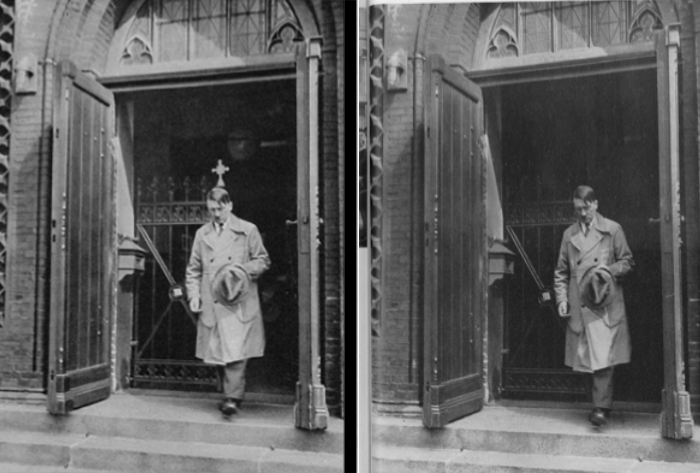A Doctored Photo of Hitler Discovered: Unraveling Hitler’s Religious Deception
In a bizarre twist, the message of the fake photo was truer than the original, which served as deceptive propaganda.
When Richard Steigmann-Gall published his controversial 2003 book, The Holy Reich: Nazi Conceptions of Christianity, 1919-1945, he hoped to show that Hitler and the Nazi Party were more Christian in their orientation than many historians had previously recognized. For his dust jacket he selected a powerful photograph from April 1932, showing Hitler emerging from a church in Bremerhaven.
In the photo, a strikingly bright white cross is hovering above Hitler’s head, giving him a halo effect. When Hitler’s private photographer, Heinrich Hoffmann, published this photo in a collection, Hitler wie ihn keiner kennt (Hitler as No One Knows Him), he provided this caption: “A photographic chance event becomes a symbol: Adolf Hitler, the supposed ‘heretic,’ leaving the Marinekirche [sic] in Wilhelmshaven.”
We will probably never be able to ascertain whether this really was a chance event, as Hoffmann claimed, or if Hoffmann and Hitler staged it, as seems more likely (especially given the odd lighting on the cross in the photo). However, clearly Hoffmann — and Hitler, who at the time was campaigning for state elections — wanted to use this photo to counter the wide-spread allegations that Hitler was anti-Christian. The photo seemed to imply that Hitler was leaving a worship service, so the message was: Relax, Hitler is not a heretic after all.
Some historians have argued that Hitler broke decisively with Christianity in 1937. This would surely explain the doctored photo and the altered caption.
Unfortunately, Steigmann-Gall did not know when he published The Holy Reich that Hoffmann later doctored this photo to craft a different image of Hitler. The 1935 edition of Hitler wie ihn keiner kennt still had the original photo, but in the 1938 edition the cross was airbrushed away, destroying this powerful symbol.

Photo on the left is the original image. Photo on the right is the doctored image.
When I discovered this recently, I was not sure at first which version was the original and which was doctored (especially since the earlier version looks too good to be true). However, fortunately, the Heinrich Hoffmann archive in Munich has the original negatives, and an archivist there examined them for me and informed me that the cross is in the original negative.
Why Remove the Cross?
Why would Hoffmann remove the cross? Given Hitler’s close relationship with Hoffmann and other considerations, this change probably was initiated by Hitler, though this is impossible to prove. Presumably, Hitler no longer wanted to be so closely associated with Christianity. The changed caption in the 1938 edition supports this interpretation, for this time it stated: “Adolf Hitler after sightseeing at the historic Marinekirche [sic] in Wilhelmshaven.”
This makes clear that Hitler was not attending a church service, as many Germans might have thought from the earlier editions. Rather he was merely viewing the architecture. No longer is this photo a symbol that Hitler is not a heretic.
Did this shift in propaganda about Hitler and Christianity mark a change in Hitler’s relationship with Christianity during the period 1935 to 1938? Or, did he no longer feel the need to pander to the electorate any longer, since he was already fully ensconced in power? Even without any knowledge of this doctored photo, some historians have argued that Hitler broke decisively with Christianity in 1937. This would surely explain the doctored photo and the altered caption.
Hitler’s Long Hostility to Christianity
However, as I demonstrate in Hitler’s Religion: The Twisted Beliefs That Drove the Third Reich, the evidence for a significant shift in Hitler’s religious views in 1937 is very weak. Hitler had expressed contempt for Christianity, both privately and even occasionally publicly, from the earliest phases of his political career. Already in the second volume of Mein Kampf (written in 1925), Hitler complained that “with the appearance of Christianity the first spiritual terror entered in to the far freer ancient world,” and he ominously threatened that “coercion is broken only by coercion, and terror only by terror.” Hitler’s disdain for Christianity was long-standing.
In examining in detail Hitler’s writings, speeches, monologues, and private conversations, as well as his associates’ diaries and memoirs, I have discovered no serious change in Hitler’s religious views from the beginning of his political career to the end of his life. There is a significant change, however, in the religious image of Hitler created by Nazi propaganda.
Before 1934, when Hitler gained full dictatorial control of the German government, Hitler did sometimes publicly make pro-Christian statements to cater to the German public. These pro-Christian statements were strongest in his early political career in the 1920s, weakened in the early 1930s, and are conspicuously absent in his post-1934 rhetoric.
Thus I conclude that ironically, the original unaltered photograph was even more deceptive than the later airbrushed version. The original photo presented a false image of Hitler to the German electorate as a devout Christian. The later edition stripped away this message, because Hitler no longer needed to cultivate this persona. In a bizarre twist, the message of the fake photo was truer than the original, which served as deceptive propaganda.
Richard Weikart is professor of history at California State University, Stanislaus, and author of Hitler’s Religion: The Twisted Beliefs That Drove the Third Reich and The Death of Humanity.







